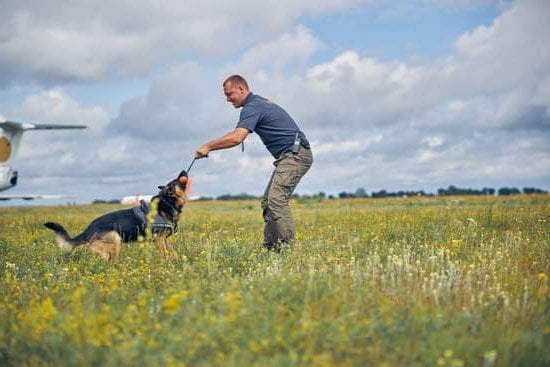What is platform training for dogs? Platform training is a highly effective method of dog training that utilizes a raised platform as a tool to teach and reinforce desired behaviors in dogs. This technique has gained popularity among dog trainers and owners due to its versatility and positive results in shaping a dog’s behavior.
Platform training involves using a designated raised platform, such as a wooden block or mat, to train dogs in various obedience skills, agility exercises, and behavioral modifications. The raised surface provides a clear boundary for the dog to follow and helps them focus on the task at hand. This method also allows for precise reinforcement of commands and encourages dogs to stay engaged and attentive during training sessions.
In this introductory section, we will delve into the fundamentals of platform training for dogs, exploring its benefits, tools and materials needed, step-by-step guide to implementation, common mistakes to avoid, advanced techniques, troubleshooting challenges, success stories from real-life examples, and the future of platform training for dogs.
Whether you are a professional dog trainer or simply an enthusiast looking to improve your canine companion’s skills, understanding platform training is key to unlocking your dog’s full potential.
The Benefits of Platform Training for Dogs
Platform training for dogs offers a wide range of benefits that can help improve your dog’s behavior and overall well-being. Here are some of the key advantages of incorporating platform training into your canine companion’s routine:
1. Improved Focus and Attention: Platform training helps dogs develop better focus and attention, making it easier for them to follow commands and learn new behaviors. By teaching your dog to target and remain on a platform, you can strengthen their ability to concentrate on specific tasks.
2. Enhanced Coordination and Body Awareness: Engaging in platform training can help dogs improve their coordination and body awareness. This is particularly beneficial for younger or older dogs, as it can help them maintain or regain physical strength and agility.
3. Mental Stimulation: Platform training provides mental stimulation for dogs, which is essential for preventing boredom and related behavioral issues. Teaching your dog new skills through platform training keeps their mind active and engaged.
In addition to these benefits, platform training also promotes positive reinforcement, strengthens the bond between you and your dog, and can be adapted to address specific behavioral challenges. By introducing platform training into your dog’s routine, you can set them up for success in various areas of their life.
Getting Started
Platform training for dogs is a highly effective method of teaching your canine companion to understand and follow commands. It involves the use of a raised platform, typically a small, sturdy surface like a wooden plank or plastic mat, to train your dog to stay in one place, improve focus, and learn new behaviors.
To get started with platform training for your dog, you will need a few essential tools and materials. First and foremost, you will need a suitable platform. This could be a commercially available dog training platform or something as simple as a yoga mat or wooden board. The key is that it should be sturdy enough to support the weight of your dog and provide enough space for them to stand comfortably.
In addition to the platform itself, you may also need some treats or rewards for positive reinforcement during training sessions. It’s important to choose treats that your dog finds highly motivating and rewarding. You’ll also want to have a leash and collar on hand, especially if your dog is still learning basic obedience commands.
Finally, having patience and consistency is crucial in platform training for dogs. The process may take time, but it can yield excellent results when approached with dedication and positivity.
| Tool/Material | Use |
|---|---|
| Raised Platform | To provide an elevated surface for training |
| Treats or Rewards | For positive reinforcement during training sessions |
| Leash and Collar | To maintain control during training sessions |
Step-by-Step Guide to Platform Training for Dogs
Platform training for dogs is a widely used and highly effective method of teaching canines various behaviors and commands. This technique involves using a designated platform, which can be a raised mat or even a simple piece of wood, to train dogs to understand commands, improve their behavior, and enhance their overall performance. Here is a step-by-step guide to help you get started with platform training for your beloved pet:
- Choose the right platform: The first step in platform training for dogs is selecting the appropriate platform. It should be large enough for your dog to comfortably stand on and sturdy enough to support their weight. You can purchase pre-made platforms designed specifically for this type of training, or you can easily create one at home using materials such as wood or foam.
- Introducing the platform: Once you have chosen the platform, introduce it to your dog gradually. Allow them to sniff and investigate the platform without any pressure or commands. This will help them feel comfortable and familiarize themselves with the new object in their environment.
- Teaching the “place” command: The next step is to teach your dog the “place” command, which instructs them to go to the designated platform and remain there until released. Start by luring your dog onto the platform with a treat, then praise and reward them once they are on it. Repeat this process several times until they understand that going to the platform results in positive reinforcement.
By following these steps and being patient with your dog throughout the process, you can effectively implement platform training into their routine.
Remember that consistency and positive reinforcement are key factors in successfully training your dog using this technique”.
Common Mistakes to Avoid in Platform Training
Using the Wrong Size or Type of Platform
One common mistake in platform training for dogs is using the wrong size or type of platform. It’s important to choose a platform that is large enough for your dog to comfortably stand and turn around on, but not so large that it becomes cumbersome. Additionally, different types of platforms such as raised beds, mats, or wooden platforms may work better for different dogs based on their size, age, and comfort level.
Inconsistency With Rewards and Reinforcement
Another mistake to avoid in platform training is inconsistency with rewards and reinforcement. Dogs thrive on consistency, so it’s important to establish clear criteria for when they will be rewarded for being on the platform and consistently reinforce those behaviors. In addition, using a variety of rewards such as treats, praise, and toys can help maintain enthusiasm and motivation during training sessions.
Skipping the Foundation Work
One of the biggest mistakes that dog owners make in platform training is skipping the foundation work. Building a strong foundation by teaching your dog basic behaviors such as sit, stay, and come will set them up for success in platform training. Without these fundamentals, your dog may struggle to understand what is expected of them on the platform and become frustrated during training sessions.
By avoiding these common mistakes in platform training for dogs and taking the time to understand your dog’s individual needs and learning style, you can set both you and your canine companion up for success in this rewarding training method.
Would You Like To Get A Platform For Your Dog?
Advanced Platform Training Techniques for Dogs
Adding Distance and Duration
Once your dog has mastered the basic platform training exercises, you can start introducing advanced techniques to further challenge and stimulate them. One way to do this is by gradually increasing the distance between the platform and yourself, as well as the duration of time they must remain on the platform. Start by giving the “stay” command and taking a step back, then gradually build up to having them stay on the platform for extended periods of time.
Introducing Distractions
Another advanced technique in platform training for dogs is introducing distractions. This can help your dog learn to maintain focus and discipline even in environments with high stimuli. Start small by introducing mild distractions, such as toys or other mild noises, while your dog remains on the platform. With practice, you can gradually increase the level of distractions to further challenge their ability to stay focused.
Combining Commands
As your dog progresses in their platform training, you can begin combining commands with their platform exercises. For example, you can have them perform a specific trick or obedience command while on the platform, such as sitting or lying down. This not only adds complexity to their training but also reinforces their understanding and responsiveness to different commands.
By incorporating these advanced platform training techniques into your dog’s routine, you can continue to engage and challenge them mentally and physically, leading to a well-rounded and disciplined canine companion.
Troubleshooting
When it comes to platform training for dogs, there can be challenges that arise along the way. It’s important for dog owners and trainers to understand how to address these challenges in order to have a successful training experience.
One common challenge that may arise is a dog’s reluctance or fear of stepping onto the platform. This can be addressed by using positive reinforcement techniques such as rewards or praise to encourage the dog to approach and eventually step onto the platform.
Another potential challenge in platform training for dogs is maintaining their focus and engagement during the training process. Some dogs may become easily distracted or lose interest, especially when learning new behaviors.
To address this, it’s important to keep training sessions short and engaging, with plenty of breaks and rewards for the dog’s good behavior. It may also be helpful to work on building a strong bond and trust between the dog and the trainer, as this can increase the dog’s willingness to participate in the training.
In some cases, a dog may exhibit unwanted behaviors such as chewing or digging at the platform instead of following the intended training instructions. This can be addressed by redirecting the dog’s attention towards the desired behavior through consistent reinforcement and gentle correction.
Additionally, ensuring that the platform itself is sturdy and secure can help prevent destructive behavior during training sessions. By addressing these common challenges in platform training for dogs, both trainers and their canine companions can work together towards successful learning experiences.
Success Stories
Platform training for dogs has shown great success in many real-life examples, proving that this method is highly effective in enhancing a dog’s behavior and skills. One success story involves a dog named Max, who used to struggle with obedience and focus during training sessions. However, after implementing platform training techniques, Max showed remarkable improvement in his ability to follow commands and maintain concentration.
Another inspiring example is Bella, a rescue dog with fear and anxiety issues. Traditional training methods seemed ineffective for Bella until her owner introduced platform training. With consistent practice, Bella displayed significant progress in overcoming her fears and gaining confidence. These success stories demonstrate the transformative impact that platform training can have on dogs’ behavior and overall well-being.
It’s important to note that while these success stories are impressive, they required dedication, patience, and proper guidance from the owners or trainers. This highlights the importance of understanding the principles of platform training and applying them consistently to achieve positive results in a dog’s behavior and skills. By learning from these real-life examples, other dog owners and trainers can be inspired to explore platform training as a valuable tool for their canine companions.
| Success Story | Description |
|---|---|
| Max | Showed remarkable improvement in obedience and focus during training sessions. |
| Bella | Displayed significant progress in overcoming fears and gaining confidence through consistent practice. |
The Future of Platform Training for Dogs
As platform training for dogs continues to gain popularity, the future of this innovative training method holds exciting developments and trends. With the ever-growing interest in positive reinforcement training, more trainers and dog owners are recognizing the benefits of platform training and incorporating it into their routines. This growing demand for effective and humane training techniques is driving advancements in platform training for dogs.
One of the key innovations on the horizon for platform training is the development of interactive digital platforms. These platforms will offer virtual environments where dogs can engage in interactive training sessions, making use of technology to simulate real-life scenarios. This approach not only provides a novel way to train dogs but also allows for customized and adaptive learning experiences based on each dog’s progress and behavioral needs.
Additionally, there is a growing focus on integrating platform training with other forms of enrichment activities for dogs. This trend recognizes that mental stimulation is just as important as physical exercise for a dog’s overall well-being.
As a result, we can expect to see an increase in the incorporation of sensory experiences, problem-solving tasks, and agility exercises within the context of platform training. By combining these elements, trainers can provide more holistic enrichment opportunities for dogs while further reinforcing their skills through platform training.
Another emerging trend in platform training for dogs involves the use of specialized equipment and tools designed specifically for this type of training. From modular platforms that can be adjusted to different heights and configurations to interactive elements such as touch-sensitive pads or sensors, there is a concerted effort to develop equipment that enhances the effectiveness and engagement of platform training.
These advancements aim to make platform training more versatile and adaptable to different environments, allowing for greater flexibility in its application for varied canine needs and abilities”.
Conclusion
In conclusion, platform training for dogs has proven to be an incredibly effective and versatile training method that offers a wide range of benefits for both dogs and their owners. From improving obedience and focus to enhancing proprioception and coordination, platform training holds immense potential for helping dogs thrive in many aspects of their lives.
With the right tools, materials, and guidance, owners can easily get started with platform training. By following a step-by-step guide and being mindful of common mistakes to avoid, anyone can begin incorporating this valuable training technique into their dog’s routine.
As the future of platform training for dogs continues to evolve, there are exciting innovations and trends on the horizon. The growing success stories of dogs excelling in various activities thanks to platform training are truly inspiring, paving the way for continued advancements in this area of canine development. As more owners embrace the power of platform training for their canine companions, we can look forward to seeing even more dogs reaching their full potential through this proven method.
Frequently Asked Questions
What Are the Benefits of Dog Platform?
The benefits of a dog platform include providing elevation for the dog during training, making it easier for them to see and follow commands. It also helps teach boundaries and can improve focus and confidence.
How to Build a Training Platform for Dogs?
To build a training platform for dogs, you’ll need to gather materials like wood, screws, and a non-slip surface. After measuring and cutting the wood to size, assemble the platform and add the non-slip surface.
What Dog Training Method Is Best?
The best dog training method is one that takes into account the individual needs and temperament of the dog. Positive reinforcement methods, such as clicker training or using treats, are often considered effective in building trust and obedience in dogs without resorting to punishment or harsh methods.

Welcome to the blog! I am a professional dog trainer and have been working with dogs for many years. In this blog, I will be discussing various topics related to dog training, including tips, tricks, and advice. I hope you find this information helpful and informative. Thanks for reading!





